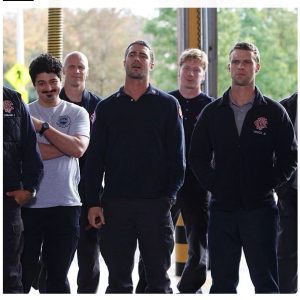Chicago Fire’s Risky Reinvention: Surviving and Thriving Without Its Core Heroes
For over a decade, Chicago Fire has captivated audiences with its pulse-pounding action, heart-stopping rescues, and moments of camaraderie between the firefighters of Firehouse 51. But as the series enters its fourteenth season, something undeniable has changed: the show is no longer the same. And in an unexpected twist, that may be exactly what the series needed to stay relevant and emotionally grounded.
The Day the Firehouse Changed Forever
The departures of some of Chicago Fire’s most beloved characters — Captain Matt Casey (Jesse Spencer), Lieutenant Kelly Severide (Taylor Kinney), and Lieutenant Stella Kidd (Miranda Rae Mayo) — were seismic moments for both the characters and fans. These weren’t just faces on the screen; they were the heartbeats of the show.
![Chicago Fire' Recap Season 6, Episode 11 — [Spoiler] Dead or Alive](https://tvline.com/wp-content/uploads/2018/01/chicago-fire-recap.jpg)
When Casey left for Portland in Season 10, the firehouse lost its steady moral center. Severide’s brooding intensity, which had perfectly balanced Casey’s calm leadership, became a rare presence due to Taylor Kinney’s personal leave. Meanwhile, Stella Kidd, the embodiment of leadership and grit, exited this season, further shifting the foundation of Firehouse 51.
Individually, their absences stung. But together, they reshaped the very fabric of the show.
A Risky Kind of Reinvention
Instead of rushing to fill these voids with high-profile replacements, Chicago Fire made a daring choice: it leaned into the emptiness. The writers didn’t shy away from showing the raw, unfiltered grief and transition that comes with such monumental changes. The show made it clear — the firehouse was adjusting to this new reality, and the change was felt in every corner of the station.
Joe Cruz found himself suddenly responsible for more than he ever anticipated, struggling to live up to legacies he didn’t ask to inherit. Darren Ritter, once hesitant in the background, was thrust into leadership roles, testing his self-confidence in the face of new challenges. Meanwhile, Violet Mikami began redefining herself in the wake of heartbreak, emerging as a more complex and resilient force on the team.
Firehouse 51 has become a real workplace in transition: imperfect, occasionally unstable, but always united by its shared mission.
The Fan Divide: Mixed Reactions to the Shift
Like any major shift in a long-running series, the reactions to Chicago Fire’s new direction have been divided. Some fans express frustration over Severide’s prolonged absence, feeling that his brief appearances only serve to remind them of what’s missing. Others find Casey’s intermittent returns bittersweet — comforting, but emotionally loaded.

However, a growing segment of the audience has praised the show’s bold approach, celebrating its realism in depicting how a team deals with long-term change. Social media conversations reflect this divide, with fans debating whether the show needs a “core four” again or if it’s better off as a more fluid ensemble. What’s clear, though, is that the fans are still deeply invested — and that’s what keeps the show alive.
Realism Behind the Risk
In real life, firehouses evolve. People transfer. Leaders retire. Friends move on. The decision to allow Chicago Fire to reflect this natural progression, instead of clinging to nostalgia, may be its most daring move yet. The show is redefining leadership, showing that it’s not fixed — it’s fluid. There’s no longer a single hero at the center of every story. The baton is passed week by week, allowing supporting characters to step up and either grow or fail in leadership roles.
This is a gamble, for sure. But it’s a gamble that keeps the series fresh and authentic, reflecting how real teams evolve when faced with inevitable change.
The Road Ahead: What’s Next for Chicago Fire?
Rumors have circulated about the potential return of Taylor Kinney as Severide, and Jesse Spencer’s occasional cameos as Casey suggest that these iconic characters may return. However, what’s notable is how little the show seems to be waiting for them. If they come back, the firehouse will welcome them with open arms. But if they don’t, Firehouse 51 will adapt, just as it always has.
Season 14 has made one thing clear: Chicago Fire isn’t about preserving the past at all costs. It’s about showing how teams survive and even thrive when their legends leave — a lesson in resilience and evolution.
Still Burning Bright
The iconic red trucks still roll out of the station. The alarms still ring at all hours. The firehouse walls remain the same. But inside, everything is shifting. And perhaps, just maybe, that’s the most authentic thing Chicago Fire has ever done.





